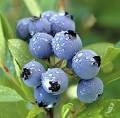
In terms of U.S. fruit consumption, blueberries rank only second to strawberries in popularity of berries. Blueberries are not only popular, but also repeatedly ranked in the U.S. diet as having one of the highest antioxidant capacities among all fruits, vegetables, spices and seasonings. They do have a short season and are quite expensive if you buy them at the grocery store when fresh. Studies have shown the frozen berries are just as nutritious even after 3-6 month of being in your freezer and easier on your pocket book, along with being available year around.
We are always thinking about the glycemic index of the food we eat and berries are considered low in terms of their glycemic index (GI). GI is a common way of identifying the impact of a food on the blood sugar level once it's consumed and digested. In general, foods with a GI of 50 or below are considered "low" in terms of their glycemic index value. Studies show the GI for blueberries as falling somewhere in the range of 40-53 depending on their sweetness.
This is also one of those fruits that grow very well in North Central AR. The Arkansas County Extension office has an excellent pamphlet on the varieties that are best for this area ....Click here, then look under Herbs & Berries for the PDF file "Growing Blueberries". To Download the 4 page pamphlet click on the PDF file.
Health Benefits
Blueberries have a rock star reputation among fruits because they contain high levels of phytochemicals, particularly anthocyanins. Anthocyanins are a pigment and are responsible for the berries intense blue color.
North American Indians, the Chinese and the Europeans used this powerful substance in their traditional herbal medicines. These medicines, typically derived from dried leaves, fruits, roots and seeds, contained anthocyanins naturally present in the plant.
Today, researchers report that anthocyanins likely play a role in:
Sources
American Institute of Cancer Research
Health Benefits Of Blueberries: 5 Reasons To Eat More Blueberries By Amy Boulanger, Jun 12, 2013
whfoods.org
We are always thinking about the glycemic index of the food we eat and berries are considered low in terms of their glycemic index (GI). GI is a common way of identifying the impact of a food on the blood sugar level once it's consumed and digested. In general, foods with a GI of 50 or below are considered "low" in terms of their glycemic index value. Studies show the GI for blueberries as falling somewhere in the range of 40-53 depending on their sweetness.
This is also one of those fruits that grow very well in North Central AR. The Arkansas County Extension office has an excellent pamphlet on the varieties that are best for this area ....Click here, then look under Herbs & Berries for the PDF file "Growing Blueberries". To Download the 4 page pamphlet click on the PDF file.
Health Benefits
Blueberries have a rock star reputation among fruits because they contain high levels of phytochemicals, particularly anthocyanins. Anthocyanins are a pigment and are responsible for the berries intense blue color.
North American Indians, the Chinese and the Europeans used this powerful substance in their traditional herbal medicines. These medicines, typically derived from dried leaves, fruits, roots and seeds, contained anthocyanins naturally present in the plant.
Today, researchers report that anthocyanins likely play a role in:
- inhibiting inflammation and tumor growth
- counteracting oxidation, a process that can damage healthy cells
- reducing risk for other diseases such as diabetes and cardiovascular disease.
Sources
American Institute of Cancer Research
Health Benefits Of Blueberries: 5 Reasons To Eat More Blueberries By Amy Boulanger, Jun 12, 2013
whfoods.org
 RSS Feed
RSS Feed
